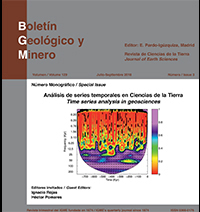Analysis of the Kobe earthquake time series via system identification and fault-detection techniques
DOI:
https://doi.org/10.21701/bolgeomin.129.3.004Keywords:
seismology, earthquakes, time series prediction, model identification, fault detectionAbstract
The Kobe earthquake was one the most severe earthquakes in Japan in recent years. It occurred on January 16, 1995, at 20:46:49 (UTC) and measured 6.8 on the moment magnitude scale. In this paper, the time series of the unbiased earth ground vertical acceleration collected by a seismograph located at the University of Tasmania, Hobart, Australia, is analyzed. The time series is segmented into three consequent sub-series which represent the normal seismic activity before the arrival of the earthquake, a transition phase, and the arrival of earthquake waves. The analysis is separately performed for each segment. We show that by inspecting the degradation of the prediction performance of the model identified based on the normal seismic activity data set, it is possible to distinguish between the transition phase and normal seismic activity about 200-300 seconds before the beginning of the earthquake phase. Though this does not mean that earthquakes can be forecasted, because of the significant data distortion due to the long distance between the epicenter and the data collection location, nevertheless the achieved result may open up new routes in the study of earthquakes.
Downloads
References
Anderson, T.W. 1971. The statistical analysis of time series. Wiley, New York.
Bittanti, S. 2017. Model Identification and Data Analysis. To appear.
Box, G.P.E., Jenkins, G.M. , Reinsel, G.C., Ljung, G.M. 2016. Time series analysis - forecasting and control. Wiley, Hoboken.
Brockwell, P.J., Davis, R.A. 2002. Introduction to times series and forecasting. Springer, New York. https://doi.org/10.1007/b97391
Durbin, J. 1959. Efficient estimators of parameters in moving average models. Biometrica, 46, 306-316. https://doi.org/10.1093/biomet/46.3-4.306
Hwang, I., Sungwan, K., Youdan, K., Seah, C.E. 2010. A Survey of Fault Detection, Isolation, and Reconfiguration Methods. IEEE Transactions on Control Systems Technology, 18, 636-653. https://doi.org/10.1109/TCST.2009.2026285
Grunwald, P.D. 2007. The minimum description length principle. MIT press, Boston. https://doi.org/10.7551/mitpress/4643.001.0001
Ljung, L. 1989. System identification - theory for the user. Prentice Hall, Upper Saddle River.
Rissanen, J. 1978. Modeling by shortest data description. Automatica, 15, 465-471. https://doi.org/10.1016/0005-1098(78)90005-5
Soderstrom, T. and Stoica, P. 1989. System Identification. Prentice-Hall, Englewood Cliffs.
Stoica, P. and Moses, R. 2005. Spectral analysis of signals. Prentice Hall, Upper Saddle River.
Downloads
Published
How to Cite
Issue
Section
License
Copyright (c) 2024 Consejo Superior de Investigaciones Científicas (CSIC)

This work is licensed under a Creative Commons Attribution 4.0 International License.
© CSIC. Manuscripts published in both the print and online versions of this journal are the property of the Consejo Superior de Investigaciones Científicas, and quoting this source is a requirement for any partial or full reproduction.
All contents of this electronic edition, except where otherwise noted, are distributed under a Creative Commons Attribution 4.0 International (CC BY 4.0) licence. You may read the basic information and the legal text of the licence. The indication of the CC BY 4.0 licence must be expressly stated in this way when necessary.
Self-archiving in repositories, personal webpages or similar, of any version other than the final version of the work produced by the publisher, is not allowed.















